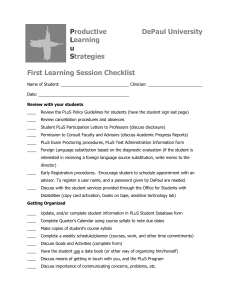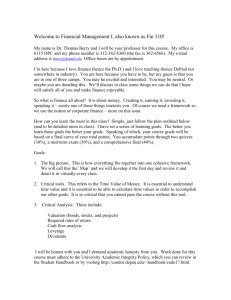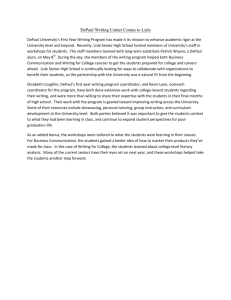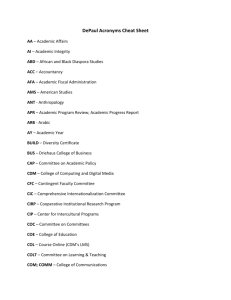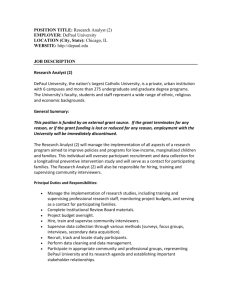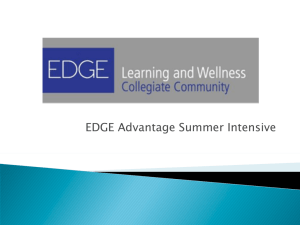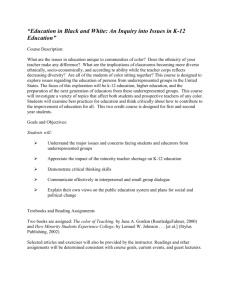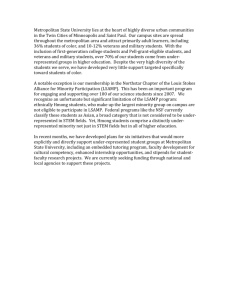A Practical Guide for Diversifying Physics
advertisement
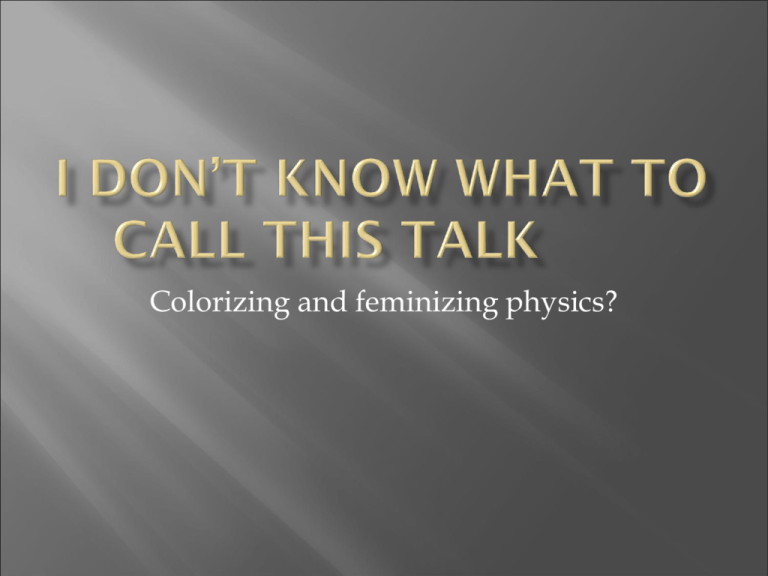
Colorizing and feminizing physics? Current status of women and minorities Why should we care Strategies at the faculty level Strategies at the student level Partnerships Recap 35000 18-24 year olds in school 30000 25000 Total (1000's) White 20000 Black Hispanic Asian 15000 Pacific Native American Mixed 10000 5000 0 1999 2000 2001 2002 2003 2004 2005 2006 2007 Population (in millions) 350 300 250 200 150 100 50 0 Population (in millions) Population trends are mirrored by trends of those in some sort of educational track However, these trends are in no way matched in physics If we agree that this needs to be corrected, how can we do it? The Search Committee Establish specific criteria that assesses the ability of the applicant to contribute to the diversity of the department— intellectually as well as in terms of underrepresented groups For example, in the teaching and research statements, ask for how the candidate will address issues of diversity Have a discussion on what indicators of a candidates interest in diversity might look like Ethnicity and gender Membership in minority organizations History of involvement Reference to sources The committee itself should be diverse Make the search proactive Consult faculty of color and female faculty in the department, or allied departments and programs Utilize person—to—person networks Personally call potential candidates Use national and regional professional minority science societies (SACNAS, NSHP, NSBP) Utilize faculty of color Ph.D. directories. Candidates may not have Physics Ph.D., but related field. Contact directly (not just fliers) HBCU’s, Minority Serving Institutions, and Tribal Colleges. Evaluation of Candidates Review the position announcement, identify primary job competencies. Discuss a rubric for evaluating candidates. Actually apply the criteria, employ a very easy to use system. For example, exceeds, meets, does not meet scale. Do not change criteria when discussing who to offer position to. Determine if you want and can recruit women and underrepresented students to your program. If answer is no, doze off until last slide. If answer is yes, then realize that you cannot be reactive. You must be proactive in your efforts. Steps to Successful Recruiting of these populations. Before recruiting: Realize that numbers are going to be pretty small. The best students are being heavily recruited, you may not be able to compete for these students. Need a faculty that is diverse. Implement cultural changes in the department that make it more open and welcoming. Recruiting: Women and minorities, on average, are much more people oriented. You have to go out and meet these students. You must go to where they are. Area high schools Community Colleges Community centers Churches Homes You must talk to the parents and understand the important role that the family plays in many of these students. There is no way around it, you must have some financial incentives Recruiting: Realize that physics (or any science) as a career is not well known in many of these communities. More than just statistics are needed, you need to describe what is exciting about physics. Your personal story may be the biggest selling point. Your department cannot do this in isolation, but it also cannot be done as part of a university wide effort alone. Divisional recruitment: recruit students for the sciences in general. Summer bridge programs. A word about retention Recruitment of women and minorities is wasted if at the same time, retention is not addressed. Students must feel connected to the department Do not rely on university wide retention offices, such as those sponsored by Office of Minority Affairs. Efforts must be localized within the division or department Retention efforts must begin from day 1. The best way to recruit and retain faculty and students from underrepresented groups is through real partnerships. High schools Two—year schools Minority professional associations Other sciences and math departments within university. Other university units, such as Career Center and Financial aid Other universities What do I mean by real. Partners must be involved in all aspects. Planning of projects Executing of plans Responsibility for success Rewards. Paper partnerships will not work. The primary purpose of the partnership is to increase diversity of the community. Let’s look at some examples. University of Arizona Math Department. PURPOSE: To create a meaningful partnership with local school districts and the area community college. Provide teachers with intensive period of professional development. University benefits from the wealth of teaching experience they bring. HOW IT WORKS: School district/community college enter into an intergovernmental agreement. Participants remain school district/community college employees with full salary and benefits while at the University. University pays the cost of replacement teacher. While at the university: Participants take courses Participate in math instruction colloquium and math education research. Interact with department faculty Teach introductory courses Vanderbilt/Fisk Program. PURPOSE: Increase the number of Ph.D. from underrepresented groups by creating a Master-to Ph.D. bridge with HBCU, Fisk University. Not a “back door”, students must satisfy same PhD requirements as all PhD students Focus is on facilitating successful mentor/mentee relationships HOW IT WORKS: Students earn a Masters degree at Fisk, with full funding support Program is individualized to the needs of each students, courses are selected to address any gaps in undergraduate preparation. Research experience provided for all students Fast-track admission into one of Vanderbilt participating PhD programs Joint faculty appointments, advising committees, social networks. DePaul CIRRUS program PURPOSE: Increase the number of science graduates from DePaul and transfer to DePaul from the City Colleges. Summer research program for students from City Colleges and DePaul Summer internship program with partner institutions. Argonne, Lincoln Park Zoo, Field Museum, Art Institute Academic year service and outreach activities Clearinghouse for REU’s, internships, financial aid, etc. Dual-Admission HOW IT WORKS: Students from City Colleges and DePaul apply for summer research program. Selection is made by all partner institutions Year 1: Students do a summer research program at DePaul (Research 101) in either Physics, Chemistry, or Biology Residence provided by DePaul Year 2: Students do research at partner research institutions. Salary is negotiated with partner institutions. Academic year activities rotate among institutions. Students from all the institutions are required to attend Characteristics: Real partnerships Partnerships are with institutions that have large populations of underrepresented students. Partnerships involve multiple departments or multiple institutions They all cost money, but many of these ideas can be implemented without high costs For Faculty recruitment. If diversity is important, then it must be written into criteria. Selection committee should be diverse. Discussion on what indicators of diversity might look like on the application. Search should be pro—active and tap into many sources to seek out candidates. Stick to criteria For Student Recruitment Go to them, don’t expect them to come to you. Be pro—active. Establish a culture in your department that is open and welcoming. Understand the culture you are trying to recruit, personal stories as opposed to facts. Team up with other natural science and math departments Partnerships are perhaps best way to do accomplish diversity goals. Establish strong connections to minority professional societies (SACNAS, NSHP, NSBP, SHPE…) Before I thank SPIN-UP for inviting me, I must be critical of APS for not leading the charge on this issue. Thanks SPIN-UP, especially you Ruth.
